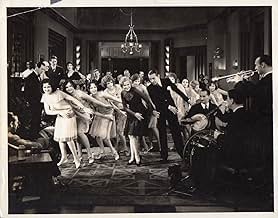June Clyde(1909-1987)
- Actress
- Soundtrack
Another vivacious blonde who made a tiny splash in Hollywood during the 30s was June Clyde. Her career was perhaps more substantial than that of many of her contemporaries. A talented songstress and dancer, June began on the vaudeville circuit in 1917 as an eight-year old, billed as 'Baby Tetrazini'. Though born in Saint Joseph, Missouri, she grew up in San Francisco. Her proper stage career kicked off in 1925 by being part of the chorus line in Topsy and Eva, which starred The Duncan Sisters. In 1929, she was signed by RKO. A couple of bit parts later, June was thrust into the limelight as the female lead in Tanned Legs (1929), a minor musical comedy set in high society (with songs by celebrated wit Oscar Levant). The picture did just enough to secure her next role in RKO's second A-grade musical Hit the Deck (1929). In 1932, June was voted one of the year's WAMPAS Baby Stars (along with Ginger Rogers). In between film work, June posed for fan magazines. Now freelancing, she received third-billing in a John Wayne western, Arizona (1931), made at Columbia. A worthier acting role was that of Teola Garfield in Fox's pre-code drama Tess of the Storm Country (1932), alongside the popular pairing of Janet Gaynor and Charles Farrell. Two years later, June also co-starred in Arthur Conan Doyle's A Study in Scarlet (1933), with Reginald Owen as Sherlock Holmes. That pretty much sums up the better part of her screen résumé. By the mid-30's, June was pretty much relegated to leads in second features and therefore decided to try her luck on the other side of the Atlantic, eventually alternating theatrical work between London's West End ("Lucky Break" (1934) and "The Flying Trapeze" (1935)) and Broadway (""Hooray for What!" (1937) and "Banjo Eyes" (1941). She also toured Australia in the late 1940s with "Born Yesterday" and "Annie Get Your Gun".
Though she was quoted in a 1935 interview (at Twickenham Studios) declaring that "Hollywood Is the dullest place on earth!", she nonetheless persevered there for most of the 40s, but, alas, cast in pictures for Poverty Row studios like Republic, or worse, PRC. Towards the end of her career, she made several films in England, the last of which was a minuscule role in a maudlin Joan Crawford melodrama, The Story of Esther Costello (1957). June eventually gave up acting and retired to Florida with her husband, the director Thornton Freeland. Her hobbies were said to have been riding, tennis and ping-pong.
Though she was quoted in a 1935 interview (at Twickenham Studios) declaring that "Hollywood Is the dullest place on earth!", she nonetheless persevered there for most of the 40s, but, alas, cast in pictures for Poverty Row studios like Republic, or worse, PRC. Towards the end of her career, she made several films in England, the last of which was a minuscule role in a maudlin Joan Crawford melodrama, The Story of Esther Costello (1957). June eventually gave up acting and retired to Florida with her husband, the director Thornton Freeland. Her hobbies were said to have been riding, tennis and ping-pong.





























